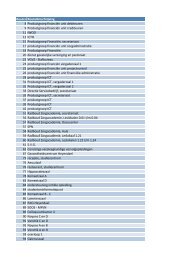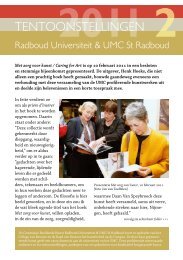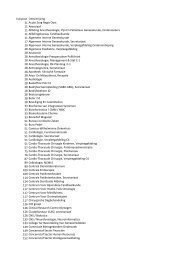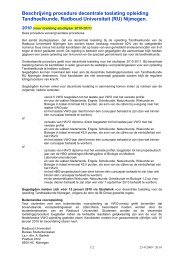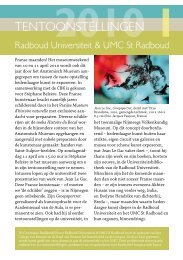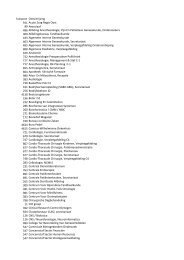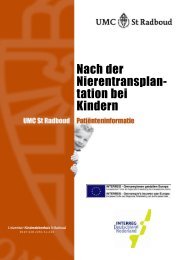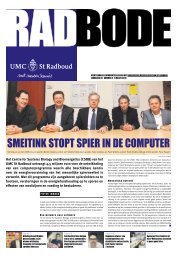Neuralgic Amyotrophy: idiopathic and hereditary ... - UMC St Radboud
Neuralgic Amyotrophy: idiopathic and hereditary ... - UMC St Radboud
Neuralgic Amyotrophy: idiopathic and hereditary ... - UMC St Radboud
You also want an ePaper? Increase the reach of your titles
YUMPU automatically turns print PDFs into web optimized ePapers that Google loves.
Specific pain symptoms in the case of a plexopathy of the shoulder<br />
In the case of a paresis of the muscles that fixate the shoulder blade to the trunk<br />
(specifically, the serratus anterior, trapezium <strong>and</strong> rhomboid), patients often complain<br />
about an increase in pain in the arm <strong>and</strong> shoulder if the limb hangs down<br />
for a long time, such as when walking or st<strong>and</strong>ing. During physical examination,<br />
it is generally also visible that the shoulder blade has slipped down on the trunk<br />
in a resting state, often laterally <strong>and</strong> downwards. Because of the weight of the<br />
arm, traction develops on the muscles fastened to the shoulder blade. Although<br />
patients should, even in such a case, try to keep the arm as pliable <strong>and</strong> mobile<br />
as possible, it could be advisable – certainly when st<strong>and</strong>ing for long periods of<br />
time or walking – to support the arm in the jacket pocket or in a sling or something<br />
similar in order to temporarily relieve pressure on the shoulder. This often provides<br />
sufficient relief.<br />
Moreover, some patients are also bothered by a kind of chronic muscular pain in<br />
the paretic postural muscles. Most shoulder <strong>and</strong> pelvic girdle muscles are unconsciously<br />
actively occupied all day long in maintaining the posture of the body <strong>and</strong>,<br />
therefore, get ‘no rest’. The ability to move our arms well, for example, especially<br />
to the front beyond our normal power, is largely dependent upon a stable shoulder<br />
blade which the arm can push against. If the muscles responsible for this are<br />
weakened, they must then tighten themselves to the maximum in order to provide<br />
any stability at all. And, they must do this all day, every day. The chronic muscular<br />
pain resulting from this, in our experience, hardly reacts to painkillers at all. Often,<br />
the best solution is to try to change position <strong>and</strong> movements frequently, not to do<br />
any one activity for too long <strong>and</strong>, in the case of an unstable shoulder blade, to rest<br />
by lying flat on one’s back.<br />
Often, topical heat is pleasant; sometimes a shoulder blade-brace offers some<br />
support.<br />
Alongside the above advice, cognition with respect to the symptom can play a role<br />
in perpetuating it. Because patients cannot see <strong>and</strong> feel their shoulder movements<br />
well, sometimes ideas develop about what is going on that do not help in<br />
the recovery <strong>and</strong> in dealing with the symptoms. For example: ‘whether or not I<br />
use it, I am still in pain’,or ‘I will avoid all use of the shoulder because every time I<br />
take something out of the cabinet, I am in so much pain’. In the chronic phase, the<br />
connection between what one does <strong>and</strong> the symptoms is often hard to explain to<br />
36<br />
the patient. It is only after sufficient explanation <strong>and</strong> after having the patient feel<br />
<strong>and</strong> experience what overtaxing does <strong>and</strong> what using the shoulder in the correct<br />
manner does with the symptoms, does it become clear to the patients <strong>and</strong> the<br />
therapists how one can work gradually on building up the capacity <strong>and</strong> seeking<br />
the balance between load <strong>and</strong> capacity.<br />
Treatment advice<br />
At the hardware level, the only worthwhile intervention is the optimization of the<br />
biomechanical situation. With the aid of the physiotherapist, one should try to recover<br />
a perishoulder blader movement pattern that is as normal <strong>and</strong> fluid as possible.<br />
Dysfunctional compensation strategies must be avoided or unlearned. Timely<br />
alternating periods of exertion <strong>and</strong> rest (the so-called “mini-breaks”) are important<br />
in order to halt surmenage. The use of a foam rubber sling to support the arm<br />
while st<strong>and</strong>ing <strong>and</strong> walking is a useful part of this approach if the m. serratus is<br />
still weak (< MRC 4). It is certainly important then to have the patient exercise the<br />
passive mobility of the shoulder at least twice a day in order to avoid contracture.<br />
There are a few important pitfalls in the physical therapy for NA. Problems occur<br />
when the exercise programme give too much load, in particular if extra weights<br />
are used while the muscle strength is still < MRC 3. Moreover, it is, in practice, not<br />
possible with a perishoulder blader paresis, to strengthen the ‘surrounding’ muscle<br />
groups without (over) taxing paretic muscles. If this is done, the pain will often<br />
increase after the session.<br />
When thinking about resuming work or hobbies, it must be explained to the patient<br />
that there is no reason to be afraid that the attacks will return or the nerve recovery<br />
will be hampered by physical exertion. At this time, it is simply not possible to<br />
predict whether or not the attacks will return, whatever one does or does not do.<br />
The level of the load follows, ideally, the amount of available muscle strength <strong>and</strong><br />
stamina <strong>and</strong> must be adapted by the patient himself because, otherwise there is<br />
a great chance of over-taxation <strong>and</strong>, consequently, a reduction in physical ability.<br />
Gradual expansion of the activities, while dividing the amount of time that one<br />
spends in a certain position (such as sitting at a computer screen) <strong>and</strong> alternating<br />
these physically taxing activities with other less taxing activities is generally a<br />
good idea as long as there is still muscle weakness <strong>and</strong> physical limitations.



